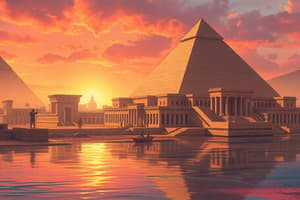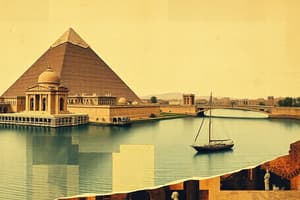Podcast
Questions and Answers
The Egyptian civilization developed over 4,000 years ago along the Nile River.
The Egyptian civilization developed over 4,000 years ago along the Nile River.
True (A)
Herodotus referred to Egypt as the 'gift of the Nile' because of its lack of agricultural resources.
Herodotus referred to Egypt as the 'gift of the Nile' because of its lack of agricultural resources.
False (B)
Cleopatra was the last pharaoh of the Egyptian civilization, and her reign ended in 30 BCE.
Cleopatra was the last pharaoh of the Egyptian civilization, and her reign ended in 30 BCE.
True (A)
The social hierarchy of ancient Egypt placed peasants above nobles and priests.
The social hierarchy of ancient Egypt placed peasants above nobles and priests.
Egyptians primarily built their houses from stone and concrete.
Egyptians primarily built their houses from stone and concrete.
The staple food of ancient Egyptians included bread made from emmer and beer made from barley.
The staple food of ancient Egyptians included bread made from emmer and beer made from barley.
Slaves in ancient Egypt were typically free citizens forced into labor due to economic hardship.
Slaves in ancient Egypt were typically free citizens forced into labor due to economic hardship.
The Egyptian civilization lasted for approximately 2,000 years without invasion.
The Egyptian civilization lasted for approximately 2,000 years without invasion.
The Sphinx has the body of a human being and the head of a lion.
The Sphinx has the body of a human being and the head of a lion.
Hieratic and demotic scripts were used by the priests and common people in ancient Egypt.
Hieratic and demotic scripts were used by the priests and common people in ancient Egypt.
The Egyptians invented the lunar calendar, which is still commonly used today.
The Egyptians invented the lunar calendar, which is still commonly used today.
The Egyptians developed the decimal system of counting, which involved counting in twos.
The Egyptians developed the decimal system of counting, which involved counting in twos.
Egyptian doctors practiced mummification to enhance their understanding of human anatomy.
Egyptian doctors practiced mummification to enhance their understanding of human anatomy.
The water clock invented by the Egyptians divided the day into 10 equal parts.
The water clock invented by the Egyptians divided the day into 10 equal parts.
The Pharaoh Ramesses II's wars with the Hittites contributed to the decline of the Egyptian civilization.
The Pharaoh Ramesses II's wars with the Hittites contributed to the decline of the Egyptian civilization.
Papyrus was not used for writing in ancient Egypt due to its inferior quality compared to clay tablets.
Papyrus was not used for writing in ancient Egypt due to its inferior quality compared to clay tablets.
The Egyptians were the first to use colored ink made with vegetable and mineral dyes.
The Egyptians were the first to use colored ink made with vegetable and mineral dyes.
Egypt was annexed into the Roman Empire in 30 CE, becoming a significant province.
Egypt was annexed into the Roman Empire in 30 CE, becoming a significant province.
The people of ancient Egypt primarily wore garments made from wool.
The people of ancient Egypt primarily wore garments made from wool.
The floods of the Nile were both a cause for anxiety and a source of fertility for farmers.
The floods of the Nile were both a cause for anxiety and a source of fertility for farmers.
Oxen were not used for ploughing the land in ancient Egypt until around 1000 CE.
Oxen were not used for ploughing the land in ancient Egypt until around 1000 CE.
Egyptians believed in multiple gods associated with various aspects of nature.
Egyptians believed in multiple gods associated with various aspects of nature.
Mummies were created by immersing the body in water for preservation.
Mummies were created by immersing the body in water for preservation.
The ancient Egyptians invented the sail to utilize wind power for their boats.
The ancient Egyptians invented the sail to utilize wind power for their boats.
The pyramids were primarily built as residences for the pharaohs during their reign.
The pyramids were primarily built as residences for the pharaohs during their reign.
The Egyptians were the first people to use metal in creating statues and tools.
The Egyptians were the first people to use metal in creating statues and tools.
The Great Sphinx is known for being constructed from multiple blocks of stone.
The Great Sphinx is known for being constructed from multiple blocks of stone.
The Nile was the main trade route used by ancient Egyptians for commerce.
The Nile was the main trade route used by ancient Egyptians for commerce.
Agriculture was considered a secondary occupation for the ancient Egyptians.
Agriculture was considered a secondary occupation for the ancient Egyptians.
Persian carpets were commonly used in Egyptian households.
Persian carpets were commonly used in Egyptian households.
Cats and dogs were kept as pets in ancient Egypt.
Cats and dogs were kept as pets in ancient Egypt.
The earliest stone pyramid was built for Pharaoh Khufu.
The earliest stone pyramid was built for Pharaoh Khufu.
Flashcards are hidden until you start studying
Study Notes
Overview of Egyptian Civilization
- Developed over 4,000 years ago alongside the Nile River in a narrow strip of fertile land.
- The Nile's geography provided natural barriers—protected by the Red Sea and Sahara Desert—ensuring relative stability for 2,000 years.
The Gift of the Nile
- Egypt receives minimal rainfall; annual floods of the Nile deposited fertile silt essential for agriculture.
- Herodotus referred to Egypt as the "gift of the Nile" due to its agricultural dependence on the river.
Early Kingdoms and Pharaohs
- Two main regions: Upper Egypt and Lower Egypt; unified around 3200 BCE by King Menes, the first pharaoh.
- Pharaohs viewed as divine figures; their rule represented a blend of religion and governance.
- Social hierarchy: pharaohs, nobles, priests, scribes, artisans, traders, laborers, and slaves.
Architecture and Housing
- Initial construction used papyrus and mud; evolved to sun-dried mud bricks for homes.
- Wealthy Egyptians had larger houses with gardens; most lived in single-storey, flat-roofed dwellings.
Diet and Clothing
- Staple foods included bread made from emmer wheat and barley beer, supplemented by various meats, fish, fruits, and vegetables.
- Clothing made from flax; women wore wrapped gowns or sheaths, while men donned loincloths or tunics. Jewellery and cosmetics were widely used.
Occupations and Economy
- Economy centered around agriculture; regular flooding of the Nile required advanced irrigation methods and administrative organization.
- Major crops cultivated included barley, emmer wheat, flax; domesticated animals provided further resources.
Pottery, Glass-making, and Carpentry
- Pottery wheels and stone vases were common; glass-making techniques were advanced.
- Carpentry yielded intricate furniture; craftsmanship reflected in tomb artifacts.
Metallurgy and Tools
- Metalworking introduced by the Hyksos; gold used in exquisite artifacts such as Tutankhamun's death mask.
Religion and Burial Practices
- Worship focused on natural forces and various deities, such as Ra (sun god) and Osiris (afterlife god).
- Belief in the afterlife led to elaborate burial practices, including mummification and tomb construction, particularly pyramids for pharaohs like Khufu.
Transportation and Trade
- The Nile served as the primary transportation route; Egyptians developed various types of boats and sails.
- Trade routes extended through the Red Sea and Mediterranean, exchanging goods like timber and copper for Egyptian products like gold and linen.
Art and Architecture
- Notable constructions include pyramids and the Great Sphinx; pyramids displayed remarkable engineering skills.
- Decorative tomb walls illustrated scenes from daily life and religious beliefs.
Writing System
- Hieroglyphics was the foundational writing system; later evolved into hieratic and demotic scripts for religious and civilian use.
- Papyrus was utilized for writing, which led to the term "paper."
Achievements in Science and Mathematics
- Development of the solar calendar, crucial for agricultural predictions; divided into 12 months of 30 days plus extra days.
- Advanced understanding of mathematics and astronomy; built pyramids using geometric principles.
Medicine
- Skilled Egyptian doctors engaged in surgery, anatomy studies, and disease diagnosis; mummification contributed to medical knowledge.
Decline of Civilization
- Pharaoh Ramesses II's reign marked imperial height; succession of wars drained resources, leading to internal strife.
- Post-1070 BCE, regional powers like High Priests of Amun gained authority, undermining pharaonic power.
- Egyptian civilization ultimately diminished through foreign invasions, culminating in 30 BCE when absorbed into the Roman Empire.
Studying That Suits You
Use AI to generate personalized quizzes and flashcards to suit your learning preferences.




